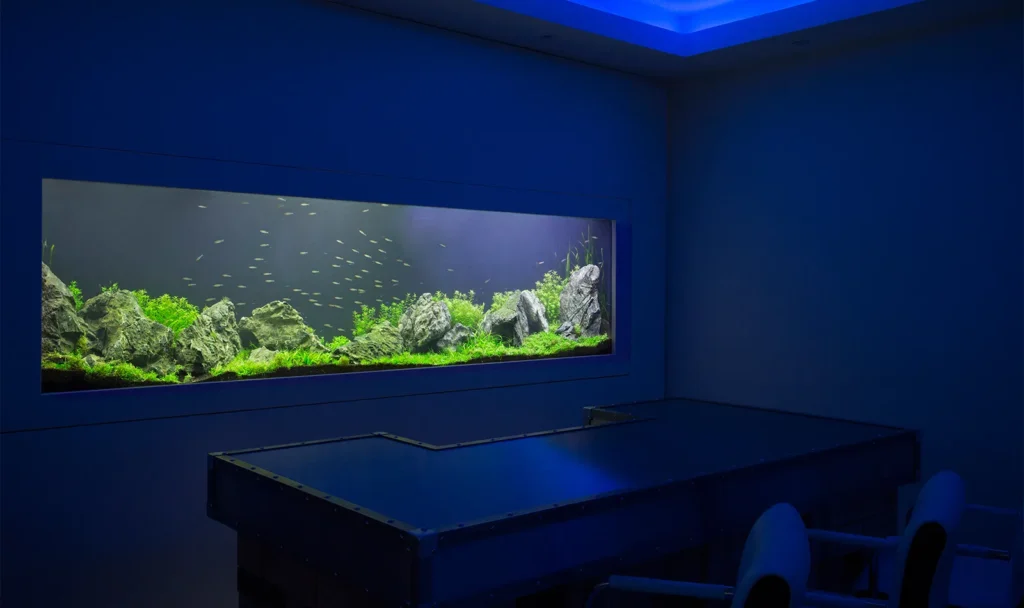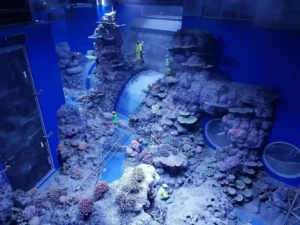Blogs
A Comprehensive Guide to Choosing the Right Lighting for Your Aquarium
Proper lighting is an essential component of any aquarium, whether it’s a small designer fish tank or a massive public aquarium. The right lighting not only enhances the visual appeal of the aquarium but also supports the health of aquatic life by mimicking natural conditions. From creating breathtaking aqua zones to fostering growth in planted tanks, choosing the appropriate lighting requires a thorough understanding of technical, aesthetic, and biological factors.
1. Why Lighting Matters in Aquariums
Aquarium lighting serves multiple purposes, including:
- Aesthetic Appeal: Enhances the vibrancy of aquatic exhibits and creates immersive architecture in public aquarium designs.
- Biological Support: Essential for photosynthesis in plants and corals, and influences the behavior of marine organisms.
- Health Maintenance: Proper lighting reduces stress in fish and promotes a healthy ecosystem.
- Showcasing Exhibits: Highlights unique features such as designer fish tanks, cylinder aquariums, or acrylic panels.

2. Types of Aquarium Lighting
Fluorescent Lighting
- Ideal for beginner setups and freshwater aquariums.
- Energy-efficient and cost-effective.
- Limited intensity makes it less suitable for deep tanks or marine aquariums.
LED Lighting
- The most versatile and widely used option for modern aquariums.
- Provides customizable light spectrums for planted tanks and marine setups.
- Energy-efficient and long-lasting, making it ideal for sustainable LSS designs.
- Advanced models integrate automation for day-night cycles.
Metal Halide Lighting
- Delivers high-intensity light suitable for deep tanks and coral growth.
- Commonly used in public aquarium designs where strong light penetration is needed.
- High heat output requires effective cooling systems.
T5 High-Output (HO) Lighting
- A compact version of fluorescent lighting with higher intensity.
- Suitable for medium-depth tanks and planted aquariums.

3. Factors to Consider When Choosing Aquarium Lighting
Type of Aquarium
- Planted Tanks: Require full-spectrum lighting for photosynthesis and plant health.
- Marine Aquariums: Blue light spectrums (actinic lights) support coral growth.
- Acrylic Aquariums: Opt for lighting that minimizes glare and enhances clarity through acrylic panels.
Depth and Size of the Tank
- Deeper tanks, such as cylinder aquariums or large public aquariums, need high-intensity lighting for uniform coverage.
- LED systems with adjustable light output are ideal for varying tank dimensions.
Energy Efficiency
- Look for energy-efficient options like LED lighting to reduce operational costs, especially in large setups like oceanariums.
- Sustainable lighting solutions align with eco-friendly practices in aquarium architecture.
Aesthetic Goals
- Choose lighting that complements the design theme, such as immersive architecture or modern clear public acrylic setups.
- RGB LED systems allow customizable colors for designer fish tanks.
Biological Needs
- Match the light spectrum to the specific needs of your aquatic life.
- Ensure day-night cycles to replicate natural habitats and promote the well-being of fish and plants.
4. Technical Aspects of Aquarium Lighting
Light Intensity and PAR (Photosynthetically Active Radiation)
- Measured in micromoles per square meter per second (µmol/m²/s), PAR indicates the light available for photosynthesis.
- Planted tanks and coral reefs require higher PAR levels.
Light Spectrum
- The color spectrum affects the growth of aquatic organisms.
- Red and blue wavelengths are crucial for photosynthesis in plants.
- Actinic blue light supports marine life like corals.
Heat Management
- High-intensity lights like metal halides generate significant heat, necessitating cooling systems or heat-resistant materials like acrylic sheets for aquariums.
Automation and Smart Controls
- Modern lighting systems integrate timers and IoT controls for seamless operation.
- Advanced Aquarium Technologies offer programmable light cycles to mimic sunrise, daylight, and sunset.
5. Common Mistakes to Avoid
- Overlighting: Excessive light can promote algae growth, especially in marine aquariums.
- Inconsistent Lighting: Irregular lighting schedules stress aquatic life.
- Ignoring Heat Impact: Neglecting heat output can compromise the tank’s environment, particularly in acrylic aquariums.
6. Step-by-Step Guide to Selecting Aquarium Lighting
Step 1: Assess Your Aquarium Design Plan
- Understand the aquarium’s purpose, size, and inhabitants.
- Work with Design Planners Architects to align lighting with overall aquarium architecture.
Step 2: Determine Biological Requirements
- Identify the light intensity and spectrum needed for plants, corals, or fish.
Step 3: Evaluate Available Lighting Options
- Compare energy consumption, lifespan, and suitability of different lighting types.
Step 4: Plan Installation
- Install lighting fixtures to minimize shadows and provide even coverage.
- Use fixtures compatible with acrylic windows for maximum visibility.
Step 5: Test and Monitor
- Measure PAR levels and adjust settings to optimize lighting for your aquarium.

How Peach Prime Consultancy Can Help
At Peach Prime Consultancy, we specialize in designing and executing custom solutions for aquariums and aquatic exhibits. We specialize in budget planning and cost estimation to ensure your project stays within financial expectations. By providing a detailed breakdown of the total project cost. Our expertise includes: • Developing aquarium lighting plans tailored to specific needs. • Collaborating with industry leaders in Aquarium Design India for advanced technologies. • Integrating energy-efficient systems for sustainable operations. • Delivering turnkey solutions from concept to installation. Transform your aquarium into a captivating and thriving ecosystem with expert guidance from Peach Prime Consultancy. Let us illuminate your aquatic vision today! We proudly serve locations in Bahrain, Cyprus, Egypt, Iran, Iraq, Israel, Jordan, Kuwait, Lebanon, Oman, Palestine, Qatar, Saudi Arabia, Syria, Turkey, United Arab Emirates (UAE), Yemen, Capital Governorate, Muharraq Governorate, Northern Governorate, Southern Governorate, Nicosia, Limassol, Larnaca, Famagusta, Paphos, and Kyrenia.












